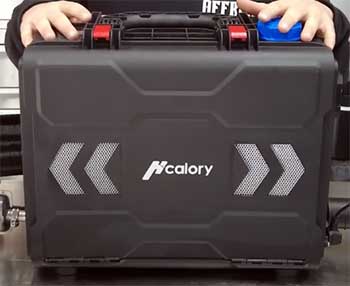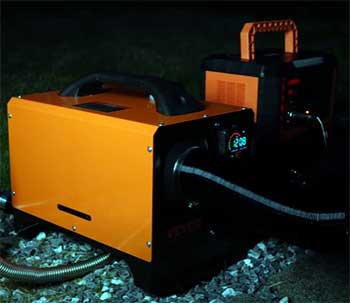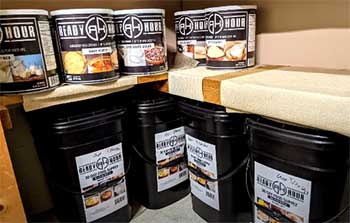Picture this: you’re out camping in the dead of winter, the stars are twinkling above, and your tent is toasty warm despite the freezing cold outside. That’s the magic I discovered with the Hcalory diesel heater, and I’m here to tell you why you need one too.
This portable, efficient, and surprisingly quiet heater transformed my outdoor adventures, making chilly nights feel like cozy evenings at home. Whether you’re an RV enthusiast, a trucker, or just someone who loves off-grid living, the Hcalory diesel heater is a game-changer you’ll wish you’d bought sooner.
Trust me, it’s worth every penny.
My Experience With The Hcalory Diesel Heater

Last winter, I decided to take my family camping in our rooftop tent, complete with an annex, despite the frosty forecast.
I’d heard about the Hcalory diesel heater from a friend who swore by it for off-grid adventures, so I took the plunge and ordered one.
When it arrived, I was excited but a bit nervous—after all, setting up a diesel heater sounded daunting.
The box was compact, with a toolbox-style design that felt sturdy yet portable, and it came with everything I needed: the heater unit, an AC-to-DC converter, a remote, and hoses for air intake and exhaust.
The first thing I noticed was the lack of clear setup instructions.
I’m no mechanic, so I spent an evening watching YouTube tutorials to figure out how to get it running. It wasn’t rocket science, but I had to check all the connections myself.
Some fuel line clamps were loose, and I tightened them with a screwdriver to avoid any leaks. The fuel tank setup was a bit tricky too—I learned the hard way to start with a small hole and use pliers to secure the o-rings for a tight seal.
Once I got it set up, though, the heater fired up like a dream. No smoke, no fuss, just a steady stream of warm air that made our tent feel like a cozy cabin.
I ran the heater for four hours on a low setting (level 2) during a test run, and it barely sipped fuel from the 5-liter tank. The heat output was impressive, keeping us comfortable even as the temperature outside dipped into the low 30s.
The app was a bit glitchy at first—I kept accidentally shutting it down because I didn’t understand the controls—but once I set a specific temperature, it worked like a charm. The remote was a lifesaver, letting me adjust settings without leaving my sleeping bag.
One thing I learned quickly: you need a solid power source. I hooked it up to a lithium iron phosphate battery, and after four hours, it only dropped from 100% to 90%. That’s efficiency you can’t argue with.
My only gripe? The power plug’s right-angle connector was awkward, forcing me to prop the unit on a 2×4 to keep it stable. But overall, this heater delivered warmth, portability, and peace of mind, making our winter camping trip unforgettable for all the right reasons.
Pros of The Hcalory Diesel Heater
- Compact and Portable Design

The Hcalory diesel heater’s toolbox design is a standout feature.
It’s lightweight, easy to carry, and fits neatly in the trunk of my car or the storage compartment of an RV.
The foldable handle makes it a breeze to move around, whether I’m setting it up for a weekend camping trip or hauling it to a remote cabin.
Unlike bulkier heaters, this one doesn’t take up much space, which is a huge plus when you’re packing for an adventure.
I’ve even moved it from my tent to my garage for a DIY project, and it’s versatile enough to handle both scenarios without breaking a sweat.
- Impressive Heat Output
This heater packs a punch. With a power output ranging from 5KW to 8KW, it can warm up a small space like a tent or RV in just a couple of minutes. During my test run, it kept our 400-square-foot tent annex at a steady 70°F, even when the outside temperature was in the single digits.
The ability to adjust the heat level from low to high means you can dial in exactly what you need, whether it’s a gentle warmth for a chilly evening or full-blast heat for subzero nights. It’s like having a fireplace you can carry with you.
- Fuel Efficiency
One of the biggest surprises was how little fuel this heater uses. On a low setting, it sips diesel at a rate of 0.1 to 0.35 liters per hour, meaning a 5-liter tank can last up to 50 hours on low mode.
Even on high, you’re looking at 16-17 hours of runtime. I ran it for four hours during my test, and the fuel level barely budged. Compared to propane heaters, which guzzle fuel and require constant refills, the Hcalory is a budget-friendly option that keeps your wallet happy while keeping you warm.
- Quiet Operation
Nobody wants a heater that sounds like a jet engine, and Hcalory nails it with low noise output. The fuel pump has a rubber isolator to reduce that annoying ticking sound, and the included muffler makes the exhaust whisper-quiet.
While there’s still some fan noise, it’s far less intrusive than older models I’ve tried. I could sleep comfortably in my tent without being disturbed, which is a big deal when you’re camping in noise-sensitive areas or just want a peaceful night.
- Versatile Power Options
The Hcalory heater’s ability to run on both 12V/24V DC and 110V/220V AC power makes it incredibly versatile. I’ve used it with a 12V battery for off-grid camping and plugged it into a wall outlet at home for testing.
The included AC-to-DC converter is a nice touch, ensuring you can power it almost anywhere. Just make sure your power source can handle the initial 10-12 amp draw at startup—more on that later.
Cons of The Hcalory Diesel Heater
- Setup Challenges

Let’s be honest: setting up the Hcalory diesel heater isn’t plug-and-play.
The lack of clear instructions made the initial setup a bit of a puzzle.
I had to rely on YouTube videos and some trial-and-error to get everything connected properly.
The fuel line clamps were loose out of the box, and I needed to double-check every connection to avoid leaks.
If you’re not handy or patient, this could be frustrating. It took me about an hour to get everything sorted, but once it was set up, it ran smoothly.
- Glitchy App Control
The Hcalory app is a great idea, but it’s not perfect. I found it a bit finicky, especially when trying to adjust settings like temperature or altitude. At one point, I accidentally shut the heater off because the interface wasn’t intuitive.
The remote control is more reliable, but I’d love to see Hcalory polish the app to match the heater’s hardware. If you’re not tech-savvy, stick with the remote or LCD panel to avoid headaches.
- Power Source Limitations
The heater’s startup power draw—over 10 amps—can be a dealbreaker if you’re using a portable power station with a standard 10-amp cigarette lighter outlet. I learned this the hard way when my power station tripped during startup.
You’ll need a battery or power source rated for at least 15-20 amps, or you’ll have to use the AC adapter with a wall outlet. This isn’t a huge issue if you plan ahead, but it’s something to consider if portability is your priority.
- Exposed Fuel Line and Tank Design
The fuel tank’s external mounting left the fuel line a bit exposed, which made me nervous about potential damage during transport. I also spilled diesel a couple of times while filling the tank, thanks to the vented cap and a less-than-ideal spillproof nozzle.
I ended up ordering a solid cap and drilling a dedicated vent to prevent leaks when the tank is tipped. The tank itself isn’t flush with the ground, so the unit can feel tippy unless you prop it up or modify the base.
- Noise at Higher Settings
While the heater is quiet on low settings, the fan gets noticeably louder when you crank it up to high. It’s not unbearable, but if you’re using it in a small space like a tent, the noise might be more noticeable than you’d like.
The muffler helps with exhaust noise, but the fan is the main culprit at higher heat levels. If you’re sensitive to sound, you might want to stick to lower settings for a quieter experience.
Maintenance Tips For Your Hcalory Diesel Heater
- Check Connections Regularly
Before you fire up your Hcalory heater for the first time, take 10 minutes to open the unit and inspect all connections. I found a couple of loose spring clamps on the fuel lines right out of the box, which could’ve caused leaks if I hadn’t caught them.
Use a screwdriver to tighten hose clamps and ensure the fuel line fittings are secure. Check these connections every few uses, especially if you’re moving the heater frequently. A quick inspection can save you from a messy fuel spill or a malfunction down the road.
- Prime the Fuel Pump Properly
Priming the fuel pump is critical to avoid startup issues. Before your first use, run the fuel pump program by pressing the power and down buttons simultaneously on the LCD panel. This fills the fuel lines with diesel, ensuring a smooth start.
I skipped this step initially and got a smoky startup, which was a rookie mistake. Once the lines are filled, press the buttons again to stop the priming mode. Do this every time you refill the tank or if the heater’s been sitting unused for a while.
- Use a Fuel Filter
Hcalory doesn’t include a fuel filter, but you’ll want to add one to prevent pump clogging. I bought a cheap inline fuel filter online and installed it between the tank and the heater. It’s a simple fix that keeps debris out of the system, extending the life of your fuel pump.
Check the filter every few months and replace it if it looks dirty. Trust me, a clogged pump is a headache you don’t want when you’re out in the cold.
- Clean the Combustion Chamber
Over time, diesel heaters can build up carbon deposits in the combustion chamber, especially if you’re using straight diesel instead of kerosene. I clean mine every 50-100 hours of use by running the heater on high for 10-15 minutes to burn off residue.
If you notice smoky startups or reduced heat output, it’s time to clean. You can also remove the chamber (carefully!) and scrub it with a wire brush if deposits are stubborn. Just make sure the unit is cool and disconnected from power before you start.
- Protect the Exhaust System
The exhaust hose gets hot—over 200°F in some cases—so you’ll want to wrap it with exhaust wrap to prevent burns or melted wires. I learned this the hard way when a stray wire touched the hose and started to melt. Keep the exhaust pipe away from flammable materials and ensure it’s vented outside to avoid carbon monoxide buildup.
Check the muffler’s weep hole regularly to make sure it’s clear, and consider adding legs to elevate it off the ground to prevent scorching surfaces.
- Monitor Battery Health
If you’re running the heater off a battery, keep an eye on its health. The initial 10-12 amp draw can strain a weak battery, so I use a lithium iron phosphate (LiFePO4) battery rated for at least 15 amps.
Check the battery’s charge level before each use, and avoid letting it drop below 20% to prolong its lifespan. If you’re using a portable power station, make sure it can handle the startup draw, or you’ll need to use the AC adapter with a wall outlet.
Comparison of Hcalory Diesel Heater With Other Brands
- Hcalory Vs. Vevor Diesel Heater

When I pitted the Hcalory against the Vevor 8KW all-in-one diesel heater, the differences came down to usability and design.
The Hcalory’s toolbox-style portability is a big win for me, as I can toss it in my car and go.
Vevor’s model is also portable but feels bulkier, with a less intuitive LCD interface that had me scratching my head.
Hcalory’s remote control is a breeze to use, while Vevor’s felt clunky.
However, Vevor offers a 10-liter fuel tank, which beats Hcalory’s 5-liter capacity for longer trips.
On the flip side, Vevor’s exhaust runs hotter, requiring extra caution, and its noise level is higher than Hcalory’s whisper-quiet operation on low settings.
Priced similarly (around $200), Hcalory edges out for its compact design and quieter performance, though Vevor’s larger tank is tempting if you prioritize runtime.
- Hcalory Vs. Webasto Diesel Heater
Comparing the Hcalory to the Webasto Airtronic AS3 D2L is like pitting a scrappy underdog against a polished pro. Webasto’s heater, priced at over $2,000, is built for permanent RV or van installations, with a sleek design and near-silent operation.
Its 2.2KW output is lower than Hcalory’s 5-8KW, but it’s incredibly efficient and starts flawlessly even in extreme cold. Hcalory, however, shines for casual users like me who need portability. I can move it from my tent to my garage without a professional installer, which you’ll need for Webasto.
The price gap is huge—Hcalory’s $200 cost makes it accessible, while Webasto’s premium build is a long-term investment. For occasional camping, Hcalory’s versatility and affordability win, but Webasto is the go-to for permanent setups.
- Hcalory Vs. LF Bros Diesel Heater

The LF Bros 5KW diesel heater, priced around $300, is another budget contender, but it falls short in a few key areas.
Hcalory’s toolbox design feels sturdier than LF Bros’ flimsier case, which I worried might dent during transport.
Both heaters offer similar heat output (5-8KW for Hcalory, 5KW for LF Bros), but LF Bros’ fan is noticeably louder, which was a dealbreaker for my noise-sensitive camping trips.
LF Bros includes a basic remote, but its controls aren’t as user-friendly as Hcalory’s, and I heard complaints about faulty glow plugs causing startup issues.
Hcalory’s fuel efficiency and quieter operation give it the edge, though LF Bros’ slightly larger 8-liter tank is a plus. For the price difference, Hcalory delivers better value and reliability for most users.
Frequently Asked Questions (FAQ)
The Hcalory diesel heater draws around 120-130 watts (10-12 amps) during startup, which is the most power-intensive phase. Once running, it sips power, using only 12-15 watts on low settings and up to 35 watts on high. This makes it efficient for long-term use, especially with a good battery or AC adapter.
Chinese diesel heaters like Hcalory are a solid choice if you’re on a budget and willing to do some setup and maintenance. They’re not as polished as premium brands like Webasto, but they deliver comparable heat output and efficiency at a fraction of the cost. Just check connections and add a fuel filter to avoid issues.
One gallon (3.78 liters) of diesel in a Hcalory heater lasts about 38-10 hours, depending on the setting. On low (0.1 liters/hour), you’ll get closer to 38 hours, while high mode (0.35 liters/hour) gives you around 10-11 hours. My tests showed minimal fuel use on low, making it great for extended trips.
A 100Ah battery can run a Hcalory diesel heater for roughly 20-25 hours, assuming minimal startups. The initial 10-12 amp draw lasts only a few seconds, and then it drops to 1-3 amps. My 100Ah LiFePO4 battery dropped 10% after four hours, so plan for a robust battery to avoid interruptions.
Why The Hcalory Diesel Heater Is A Must-Have?
After spending a winter with the Hcalory diesel heater, I’m convinced it’s a must-have for anyone who loves outdoor adventures or needs reliable heat on the go. Its compact design, impressive heat output, and fuel efficiency make it a standout, despite a few setup quirks and a glitchy app.
Whether you’re camping in a tent, living in an RV, or heating a garage, this heater delivers warmth and comfort without breaking the bank. Don’t let cold nights keep you indoors—grab a Hcalory diesel heater and make every adventure cozy.

